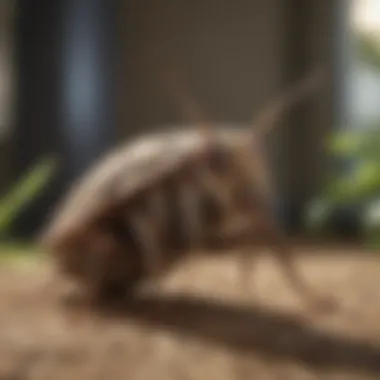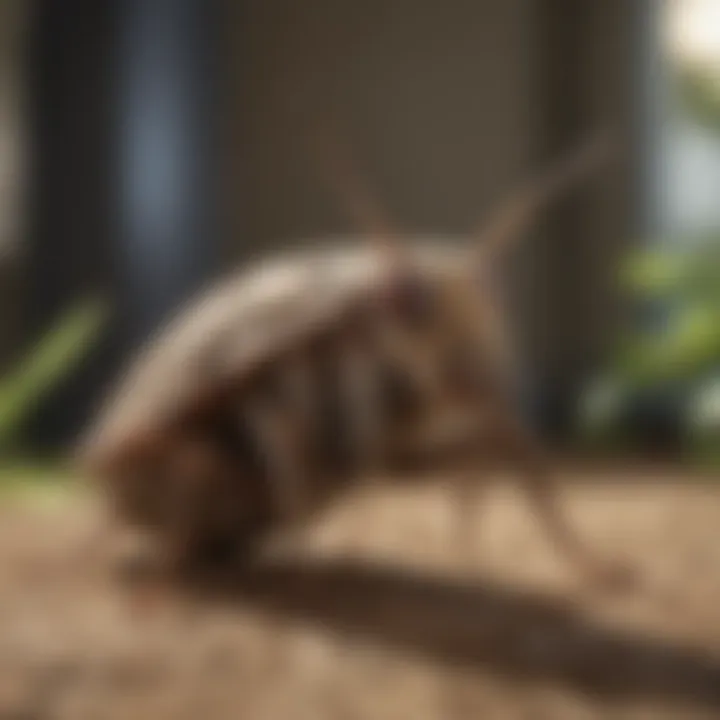Modern Pest Control Services in Maine: A Comprehensive Overview


Preventive Pest Control Strategies
Maintaining a pest-free home is a multifaceted task. It begins with effective preventive strategies, designed to deter pests before they become a problem. In Maine, understanding the specific environmental conditions is key in developing a robust pest prevention plan.
House Exterior Protection
To fortify the outer defenses of your home, consider the following:
- Sealing Cracks: Regularly inspect the exterior for cracks in walls, windows, and doors. Fill gaps with caulk or other sealants to block entry points. This stops pests from making your home their residence.
- Clearing Debris: Keep the area around your home clean. Remove leaf litter, wood piles, and overgrown plants. Debris forms nesting sites for many pests.
- Preventing Pests from Entering: Install door sweeps and window screens to ensure pests stay outside. These barriers also help maintain temperature control in your home.
Yard Maintenance
Proper yard care helps reduce pest populations. Essential routines include:
- Regular Mowing: Keeping grass short limits habitat for insects, like ticks and mosquitoes.
- Pruning Plants: Trim bushes and trees to allow air circulation.
- Soil Checks: Ensure proper drainage to avoid stagnant water, which attracts mosquitoes.
Indoor Cleanliness
An organized, clean home is less attractive to pests. Consider these expert tips:
- Frequent Cleaning: Dust and vacuum regularly. Even small crumbs can attract unwanted guests like ants or cockroaches.
- Pest-Resistant Environment: Store food in airtight containers. Ensure all items are sealed after use, especially sugary products that entice pests.
Garbage Disposal
Effective waste management plays a significant role. Key practices include:
- Efficient Waste Disposal: Use sealed bags for trash. Take out garbage regularly to prevent attracting pests.
- Proper Garbage Disposal: Do not leave food scraps outside. This encourages pests, particularly raccoons and rodents, to thrive.
Other Pest Prevention Strategies
Beyond the basics, here are innovative methods to guard your home:
- Inspecting Packages: Check deliveries for pests before bringing them inside.
- Using Barriers: Consider weatherproofing your yard with gravel or wood chips, as these materials deter some pests.
Identifying Pest Risk Areas
Identifying areas where pests can thrive is crucial to prevention. Addressing these risk zones early mitigates larger infestations in the future.
Moisture Prone Areas Inspection
Examine potential damp locations:
- Identifying Damp Conditions: Check basements, under sinks, and around the foundation. Look for signs of water intrusion or mold.
- Preventing Infestations: Use dehumidifiers to reduce moisture levels. Maintain proper ventilation to dry out these spaces.
Crack and Crevice Inspection Guide
Insects often need only a small space to enter:
- Inspecting Access Points: Regularly check areas like window frames and door hinges.
- Sealing Cracks and Crevices: Use silicone-based caulk or expandable foam to secure these gaps.
Greenery Inspection for Pest Risks
The relationship between plants and pests is vital to grasp:
- Understanding Greenery's Impact: Some plants can attract insects. Know which plants are in your yard and their pest potential.
- Guidelines for Maintaining Pest-Free Yards: Regularly inspect and care for greenery. Remove dead plants that can function as pest habitats.
Additional Pest Risk Areas
Look beyond common areas:
- Miscellaneous Pest Risk Areas: Consider attics, garages, or porch spaces. Ensure these areas are clean and well-maintained.
Effective Pest Control Methods
Once pests invade, effective control methods become necessary. Here are various strategies:
Natural Repellents for Pest Control
Utilizing nature can provide safe alternatives:
- Safe and Effective Natural Solutions: Consider using diatomaceous earth or vinegar.
- Use of Essential Oils, Herbs, and Plants: Scents like peppermint and tea tree oil can help deter pests naturally.
Chemical Sprays for Pest Control
In cases of severe infestation, chemical solutions may be warranted:
- Safe Usage of Professional Sprays: Always follow label instructions carefully.
- Eradicating Pests with Chemical Solutions: Target specific pests to manage populations while being mindful of surrounding non-target species.
Pest Traps: Effective Pest Control Solutions
Setting up traps can manage pest numbers:
- Setting Up and Using Pest Traps: Place traps in suspected areas of activity, like kitchens or basements.
- Capturing and Removing Pests Safely: Regularly check and empty traps to enhance effectiveness and prevent odors.


Biological Control Methods for Pest Prevention
Natural methods can be beneficial:
- Using Natural Predators: Introducing predatory insects can help keep populations in check.
- Environmental-Friendly Pest Control Techniques: Ensure that whatever methods used are safe for the environment.
Other Pest Control Methods
Consider unique methods that may apply:
- Innovative Pest Control: Stay informed about new developments in pest control technology that may be applied to your home environment.
Prelude to Pest Control in Maine
Pest control in Maine plays a crucial role in maintaining the delicate balance of the state's ecosystems while also protecting property and public health. Maine's unique geographical and environmental characteristics make it particularly susceptible to a variety of pests, including insects, rodents, and other wildlife. Understanding pest control is not merely about elimination; it encompasses a holistic approach that includes prevention, monitoring, and sustainable management strategies. This article aims to explore the nuances of modern pest control services in Maine, detailing methodologies, technological advancements, and regulatory frameworks.
The significance of pest control extends beyond merely dealing with annoying insects or rodents. It is essential for safeguarding homes, ensuring agricultural productivity, and minimizing health risks associated with pests. Householders and property owners must recognize the impact pests can have not only on their immediate environment but also on local ecosystems.
Through effective pest management practices, such as Integrated Pest Management (IPM), homeowners can manage pest populations with minimal environmental impact. In this context, IPM combines various strategies including biological control, habitat manipulation, and the judicious use of pesticides. This balanced approach also encourages community involvement in pest management efforts, highlighting the importance of education about pest biology and ecology.
"Effective pest control is an ongoing process requiring awareness, education, and adaptability to changing pest dynamics."
Furthermore, the importance of pest control in Maine is augmented by the state’s commitment to employing eco-friendly practices whenever possible. Challenges that arise, such as pesticide resistance or public misconceptions about pest control, demonstrate the need for continual education and adaptation in pest management practices.
Additionally, modern pest services are not solely reactive. They emphasize proactive measures that can prevent pest infestations before they occur. This focus on prevention underscores the importance of understanding pest behaviors, seasonal patterns, and the specific vulnerabilities of properties. By staying informed and working with pest control professionals, homeowners can enjoy peace of mind knowing their living spaces are secure and healthy.
In summary, the importance of pest control in Maine lies in protecting public health, property, and the environment. This foundational understanding will frame our exploration of the historical context and current landscape of pest management strategies in the state.
Historical Context of Pest Management
Understanding the historical context of pest management is essential in grasping how modern pest services in Maine have evolved. This context involves recognizing the origins, progression, and influence of past techniques on current practices. Awareness of historical approaches aids in understanding the principles that guide modern pest solutions and the lessons learned from earlier methods.
Pest management has been a part of human civilization for centuries. Early societies relied on primitive techniques for pest control, often using natural substances or employing physical barriers to protect crops. This laid the groundwork for more systematic approaches later. By examining these historical methods, we gain insight into why some solutions were abandoned and others refined.
Evolution of Pest Control Techniques
The evolution of pest control techniques can be traced back to ancient practices that often combined cultural and biological controls. For example, the Egyptians used cats to control rodent populations, while ancient Chinese texts mention the use of birds to manage pests.
Over time, methods became more sophisticated. The introduction of synthetic chemicals in the 20th century marked a significant shift. These new pest control products, such as DDT, showed rapid effectiveness. However, they also brought about considerable consequences, including resistance in pest populations and environmental concerns. This historical understanding is crucial because it highlights why contemporary methods focus more on integrated approaches that emphasize sustainability.
Early Methods vs. Modern Practices
In the early days of pest control, methods were simple and often ineffective over time. Farmers relied heavily on manual labor and natural predators. Practices such as crop rotation helped manage pest populations but required in-depth knowledge of agriculture.
Modern pest management embraces technological advancements and increased knowledge of pest biology. Methods now include:
- Chemical Treatments: Targeted application of pesticides tailored to specific pests with reduced environmental impact.
- Biological Control: Utilization of natural enemies to manage pest populations, such as releasing ladybugs to control aphids.
- Cultural Practices: Understanding the life cycles of pests promotes strategies like planting resistant plant varieties.
Innovation has transformed pest management, shifting the focus from merely extermination to holistic management. This shift is particularly pertinent in Maine, where ecological considerations are paramount.
"Modern pest control blends technology and ecology, striving for effectiveness without harming the environment."
The lessons derived from early pest management inform current practices. They emphasize the importance of adapting strategies that are sustainable and effective. Continued challenges, such as resistance to chemicals, underscore the need for ongoing innovation in pest control methodologies.
Overview of Modern Pest Control Services
Modern pest control services play a critical role in maintaining health and safety in both residential and commercial environments. The increasing complexity of pest issues in Maine has necessitated sophisticated methods and integrated approaches. With varied pest challenges ranging from rodents to insects, understanding the scope and efficacy of these services is essential. This section aims to deliver insights into the types of services available and the distinctions between residential and commercial pest control offerings.
Types of Pest Services Offered
Pest management comprises several service types tailored to specific situations. Some common options include:
- General Pest Control: This involves assessing and managing common pests like ants, roaches, and spiders in household settings.
- Termite Control: Specialized treatment focusing on controlling and preventing termite infestation, which can cause significant structural damage.
- Rodent Control: Techniques aimed at eliminating rats and mice, which pose health risks and can damage property.
- Wildlife Management: Focusing on the humane relocation of larger pests such as raccoons, skunks, or squirrels that may invade living spaces.
- Bed Bug Treatment: Targeted methodologies to eradicate bed bugs, which are increasingly prevalent and difficult to manage.
Each type of service addresses specific pest challenges and requires unique knowledge, tools, and techniques. Clients benefit from understanding which services align best with their problems.
Residential vs. Commercial Services
There's a marked difference between pest control in residential versus commercial settings.
Residential Services
Residential pest control typically focuses on maintaining a safe and comfortable home environment. Homeowners usually opt for recurring services to preempt pest issues. These services often include:
- Initial inspection and treatment
- Regular follow-ups and maintenance programs
- Tailored approaches based on types of pests common in the area
Residential pest control providers emphasize personalized service, ensuring that treatments consider the family's health and preferences.
Commercial Services
For businesses, effective pest management is crucial. A pest infestation can not only harm property but also damage a brand's reputation. Commercial pest control services often include:
- Comprehensive assessments of larger facilities
- Reports documenting infestations and treatments
- Compliance with health and safety regulations
- Customized plans for different types of businesses, from restaurants to warehouses


Commercial pest control has a focus on prevention strategies and often employs more rigorous monitoring systems.
"Understanding the differences between residential and commercial pest services helps in selecting the right approach for specific needs."
Ultimately, the choice between residential and commercial pest control will depend on individual circumstances, including the type of property and the specific pest issues concerned.
Technological Innovations in Pest Control
Technological innovations play a vital role in the effectiveness of pest control services. In Maine, where agricultural and residential areas often face unique pest challenges, the integration of advanced technologies has changed how pest management is approached. These innovations not only enhance service efficiency but also provide sustainable options to deal with pest issues. Customers are looking for solutions that are effective yet minimally invasive, making these technologies increasingly important in modern pest management.
Smart Pest Monitoring Systems
Smart pest monitoring systems utilize technology such as sensors and apps to track pest movements and detect infestations in real-time. These systems are designed to provide accurate data on pest populations and their behaviors. By receiving alerts, homeowners can address possible pest problems promptly, often before they escalate into larger issues. Here are some key aspects of smart monitoring systems:
- Real-time Data: Users can receive immediate updates about pest activities, allowing for proactive measures.
- Cost Efficiency: By knowing exactly when and where to apply treatments, unnecessary expenses can be avoided.
- Reduced Chemical Use: These systems facilitate targeted applications of pest control products, minimizing the environmental impact.
The effectiveness of smart pest monitoring rests on the combination of technology and user engagement. Homeowners who actively monitor their environments can maintain healthier living spaces while ensuring they are not contributing to broader ecological problems.
Eco-Friendly Pest Control Technologies
Eco-friendly pest control technologies represent a shift towards sustainable practices in pest management. These methods tend to reduce chemical exposure and focus on natural alternatives to pesticide use. For residents seeking healthier living conditions, eco-friendly technologies are increasingly appealing. Important components include:
- Biological Control: This method involves using natural predators to manage pest populations. For example, introducing ladybugs can help control aphids.
- Botanical Pesticides: Derived from plants, these substances offer effective control without the toxicity associated with synthetic chemicals. Products like neem oil and pyrethrins are examples.
- Trap Systems: Modern traps designed to attract and eliminate pests without chemicals are becoming popular. They are safe for pets and children, addressing concerns about traditional pest control methods.
By implementing eco-friendly technologies, homeowners can achieve satisfactory pest management while also prioritizing the health of their families and the local ecosystem. As more people become aware of the ecological impacts of pest control, the demand for these technologies is expected to rise.
Regulatory Framework Governing Pest Services
The regulatory framework governing pest services is crucial for ensuring effective pest management while protecting public health and the environment. In Maine, the interaction between state and federal regulations plays a vital role in shaping the practices of pest control services. Understanding these regulations is essential for homeowners and individuals looking to engage professional pest services. The key components include the guidelines for pesticide usage, training and certification for pest control professionals, and compliance with environmental standards. This framework not only safeguards users of pest services but also helps maintain ecological balance.
State Regulations in Maine
Maine has established a detailed set of state regulations that govern pest management activities. The Maine Board of Pesticides Control oversees the licensing and certification of pest control professionals. These regulations ensure that practitioners are knowledgeable about safe pesticide applications and the potential impacts on the environment.
Key elements of Maine’s state regulations include:
- Licensing Requirements: Pest control companies must obtain the appropriate licenses, which requires passing exams that cover pest management practices.
- Restricted Use Pesticides: Certain chemicals are classified as restricted. Only certified applicators can purchase and apply these substances. This regulation helps limit exposure and promotes safer alternatives.
- Reporting Requirements: Pest control services must report pesticide applications to ensure transparency and accountability. This can help in monitoring the effects of pesticide usage on local ecosystems.
- Public Notice: Companies must often notify residents before applying certain pesticides, creating awareness and enabling community cooperation.
These regulations are essential for fostering trust between pest control services and the communities they serve.
Federal Guidelines and Compliance
Alongside state regulations, there are federal guidelines that affect pest management practices in Maine. The Environmental Protection Agency (EPA) plays a significant role in regulating pesticides at a national level. Compliance with these guidelines ensures that pest control services adhere to safety and efficacy standards.
Important aspects of federal compliance include:
- Pesticide Registration: All pesticides used must be registered with the EPA. Unregistered substances cannot be legally used, which protects consumers from harmful chemicals.
- Labeling Standards: The EPA mandates clear labeling of pesticides, detailing their safe use, potential hazards, and application restrictions. Following these labels is crucial for the effective and safe use of these products.
- Health and Environmental Assessments: Before a pesticide can be registered, the EPA conducts thorough evaluations to assess its potential risks to humans and ecosystems. This assessment prevents dangerous substances from entering the market.
- Enforcement Actions: The EPA has enforcement powers to take action against non-compliant companies. This can include fines and sanctions, ensuring that pest control services follow regulations diligently.
Understanding these federal guidelines is vital for pest control operators and consumers alike, as they promote safer and more environmentally friendly pest management practices.
Common Pests in Maine and Their Management
Understanding the common pests in Maine and their management is crucial for effective pest control services. This region faces specific pest challenges due to its unique climate and geography. Homeowners must be aware of prevalent pests to devise suitable management strategies that protect their homes and health.
Identifying Regional Pest Issues
In Maine, some pests are more common than others due to the climate and available resources. Common pests include ants, termites, rodents, and various insects. These pests can cause structural damage, health hazards, and inconvenience for homeowners.
Ants, like the carpenter ant, are prevalent. They can compromise the structural integrity of a home as they nest in wood. Rodents, such as mice and rats, thrive in both urban and rural settings, posing health risks through contamination and disease transmission.
Termites are another significant concern. They can silently eat away at wooden structures, leading to costly repairs. Homeowners often do not realize their presence until serious damage has occurred.
To identify these pests, homeowners should look for signs such as droppings, damage to wood, and nests in hidden areas. Regular inspections by professionals can help in early detection and treatment.
Best Practices for Specific Pests
Addressing pest problems requires tailored strategies. Here are some best practices for managing specific pests in Maine:
- Ants: Use baits that attract ants and poison them. Sealing entry points also helps in preventing their reentry.
- Rodents: Implement traps and seal any cracks or openings in the home. Maintain cleanliness to reduce food sources.
- Termites: Regular inspections are key. Treat wood with preventative chemicals and use barriers during construction.
- Insects: For mosquitoes and ticks, remove standing water and treat grassy areas with eco-friendly repellents. Maintaining landscaping can reduce tick habitats.
Effective pest management requires homeowner dedication. Knowing the specific pests and how they behave guides effective action.
Customer Considerations When Choosing Pest Services
When opting for pest control services, customers face a range of considerations that can significantly influence the effectiveness of the chosen service. Recognizing what to look for in a pest control provider is crucial for homeowners and business owners alike. Making an informed decision can ensure that the pest problem is addressed swiftly and comprehensively.
Evaluating Service Providers
Evaluating service providers involves assessing various aspects of pest control companies. Here are some elements to consider:
- Licensing and Certification: Ensure the company is licensed in Maine and has certified technicians. This can assure clients that they meet state regulatory requirements.
- Reputation and Reviews: Research the company’s reputation through online reviews and testimonials. Websites like Yelp or Angie's List can provide insights into customer satisfaction.
- Experience: Consider how long the company has been in business. Longevity often reflects reliability and expertise in pest management.
- Protocols and Safety: Ask about their pest control methods, especially regarding safety protocols. A good service provider should be transparent about the chemicals used and the safety of those chemicals for children and pets.
- Consultation Services: Many companies offer free consultations. This can help you gauge their level of professionalism and knowledge before making a decision.
As a general rule, clients should choose service providers that align with their expectations for professionalism and effectiveness.


Choosing the right pest service is not just about immediate solutions; it’s also about ensuring long-term safety and effectiveness for your home or business.
Understanding Pricing Structures
Understanding pricing structures is vital for customers. Transparent pricing can prevent unexpected charges later. Here are some factors that might affect pricing:
- Type of Pest: The pest in question can influence the price. Some pests may require specialized treatments, which can be more expensive.
- Service Type: Determine if you need a one-time service or an ongoing maintenance plan. Long-term contracts may offer financial advantages.
- Extent of Infestation: Heavier infestations usually command higher prices due to the additional labor and resources required.
- Geographic Location: Prices can vary based on the region in Maine. Urban areas may incur higher charges than rural settings.
- Guarantees and Follow-ups: Some companies provide guarantees with their services. Understanding the terms can reflect on pricing, as guaranteed services may cost more upfront but provide more assurance.
Customers should ask for detailed quotes and clarify any hidden fees before committing to a service. This proactive approach will foster a better understanding of what to expect financially.
Sustainability in Pest Management
Sustainability in pest management represents a significant movement towards environmentally responsible practices in the pest control industry. This approach emphasizes long-term ecological health while managing pest populations effectively. In the context of Maine, where unique ecosystems face challenges from invasive species and climate change, the importance of sustainable pest management cannot be understated. It offers a balanced method that prioritizes not just the immediate solution to pest problems but also the lasting health of the environment.
The core element of sustainability in pest management lies in Integrated Pest Management (IPM) strategies, which combine biological, cultural, mechanical, and chemical tools in a way that minimizes risks to human health, beneficial organisms, and the environment. These strategies promote the use of monitoring techniques to identify pest populations and their life cycles, ensuring that interventions occur only when needed. This is a stark contrast to the traditional pest control methods that often rely heavily on pesticides.
Adopting sustainable practices has numerous benefits. For example, it reduces dependency on chemicals, which can have harmful side effects on non-target species and water supplies. Additionally, sustainable methods are often more cost-effective in the long run, leading to lower expenses for homeowners and businesses. Sustainable practices also help in maintaining a healthy ecosystem, which is vital for biodiversity and resilience against future pest invasions.
Integrated Pest Management (IPM) Strategies
Integrated Pest Management encompasses a multifaceted approach designed to manage pests in a way that is effective, environmentally sound, and economically viable. The strategies within IPM are based on understanding pest behavior and life cycles to implement control methods that target the specific life stage of the pest.
- Monitoring and Identification: Regular observation and accurate identification are crucial. Understanding what pests are present and when they appear can help determine the best time to act.
- Prevention: This involves practicing good sanitation, proper storage of food, and sealing entry points in buildings to discourage pest access. Preventive measures often significantly reduce pest populations.
- Control Methods: Chemical controls are used sparingly, with preference given to non-chemical methods when possible. This may include encouraging natural predators, using traps, and employing cultural practices that deter pests.
- Evaluation: Regular assessment of the pest management efficacy is important. Adjustments to strategies are made based on this evaluation to ensure the highest level of success.
Implementing IPM not only conserves the surrounding environment but also engages homeowners and property managers in the process, fostering a more collaborative effort in pest management.
Impact on Local Ecosystems
The impact of pest management on local ecosystems is profound. Using conventional pest control methods can lead to pesticide runoff, which adversely affects soil and water quality. Sustainable pest management strategies, on the other hand, seek to minimize this risk, promoting healthier ecosystems.
Sustainable practices in pest management contribute to biodiversity by reducing the harmful effects of chemicals on non-target organisms, including beneficial insects like pollinators and natural pest predators. Maintaining a balanced ecosystem helps in controlling pest populations naturally, reducing the need for chemical interventions.
Furthermore, careful management of pest control practices can lead to healthier food systems. By conserving local wildlife and plant species, we ensure the food web remains intact, supporting both the environment and agriculture.
"Sustainable pest management not only helps keep pests in check but also safeguards our vital local ecosystems, ensuring they thrive for future generations."
In summary, sustainability in pest management is essential not just for addressing current pest issues but for preserving the environmental integrity of Maine. As the demand for responsible practices increases, understanding and integrating these methods becomes crucial for homeowners and businesses alike.
Challenges Facing the Pest Control Industry
The pest control industry in Maine is not without its challenges. These issues can affect the effectiveness and perception of pest control services. Understanding these elements is crucial for both service providers and homeowners.
Resistance to Pesticides
One significant challenge is the growing resistance to pesticides. Many pests have evolved over time, developing resistance to commonly used chemicals. This can lead to a situation where standard pest control methods are no longer effective. As a result, pest control companies may need to rely on more potent and potentially more harmful chemicals. This not only escalates costs but also raises concerns about safety and environmental impact.
Increasing pesticide resistance can create a cycle where more aggressive treatments become necessary, ultimately jeopardizing ecosystems and public health.
To combat this issue, integrated pest management (IPM) strategies are being emphasized. IPM incorporates various tactics, combining chemical treatments with biological controls and habitat management. This approach not only aims to reduce the reliance on pesticides but also seeks to improve long-term pest management solutions. Homeowners should be aware of the limitations of chemical treatments and consider services that employ a more holistic pest control approach.
Public Perception and Misconceptions
Another significant hurdle is public perception and misconceptions regarding pest control methods. Many people harbor fears about the chemicals involved in pest treatment processes. This hesitance can lead to resistance in seeking professional help, despite pest issues potentially compromising health and property.
Common misconceptions include the belief that all pest control services use harmful chemicals or that DIY methods are just as effective as those offered by professionals. The reality is that licensed pest control services adhere to strict regulations regarding chemical usage and environmental safety. Education is key to dispelling these myths. Service providers must communicate openly about the strategies they employ and the science behind their methods.
In summary, the pest control industry in Maine faces challenges from pesticide resistance and public misconceptions. Industry stakeholders must address these issues directly to maintain relevance and effectiveness in their services. Homeowners should seek services that prioritize sustainable practices and are transparent about their strategies.
Future Directions in Pest Control Services
The evolution of pest control practices is crucial for adapting to the changing landscape of environmental awareness and technological advancements. As pest control grows more sophisticated, the methodologies used are increasingly designed to reflect a balance between managing pest populations and minimizing ecological disruption. For residents of Maine, an understanding of these future directions provides insights into how pest management strategies will become more effective and sustainable.
Emerging trends focus not just on eliminating pests but on developing integrated solutions that consider the broader implications. This includes aspects such as public health, environmental sustainability, and long-term efficacy of pest control methods. With an influx of advanced technologies and shifting societal expectations, pest control services are poised to transform significantly.
Trends Impacting the Industry
Several trends are pivotal in shaping the future of pest control services. They include:
- Increased Focus on Sustainability: The demand for environmentally responsible pest management solutions continues to rise. Homeowners are increasingly aware of the potential negative effects of chemical pesticides on local ecosystems. This leads to greater interest in integrated pest management (IPM) approaches that prioritize ecological balance.
- Use of Smart Technology: The adoption of smart technology, including IoT devices, smart traps, and monitoring systems, is becoming more prevalent. These technologies allow for real-time monitoring of pest activities, leading to timely and targeted interventions.
- Public Awareness and Education: With the rise of social media, public knowledge about pest control options has expanded. Homeowners are now likely to research and inquire about safe and effective pest management solutions before selecting service providers.
By staying attuned to these trends, service providers can better meet the expectations of their clients while ensuring effective pest management solutions.
Advancements in Research and Development
Research and development in pest control continue to yield promising advancements that enhance methodologies used in Maine. Components of this advancement include:
- Biological Control Methods: Research into natural predators and microbial pests aims to reduce reliance on chemical pesticides. Biological methods often provide a more balanced approach to pest management.
- Precision Pest Management: This concept involves the use of data analytics and geographic information systems (GIS) to inform pest control strategies. These technologies enable service providers to assess pest presence more accurately and apply targeted treatments.
- Innovations in Trap Design: New traps that utilize baiting systems and smart sensors make pest detection more efficient. These traps can alert service providers when a pest is captured, reducing the need for repeated visits and saving costs for homeowners.
Epilogue and Summary of Findings
The conclusion of this article is significant in emphasizing the crucial aspects of modern pest control services in Maine. It encapsulates our exploration into the effective methodologies, regulatory frameworks, and innovative technologies that govern pest management today. Understanding these elements is vital for housewives and homeowners who seek practical solutions to manage pests effectively while maintaining the ecological balance of their environments.
Essential Takeaways
- Diversity in Pest Control: There are varied pest control methods tailored to specific needs, such as residential versus commercial services. This diversity allows homeowners to select the most suitable options for their circumstances.
- Technological Integration: Modern pest control increasingly involves innovative technologies, such as smart monitoring systems. These solutions provide real-time data on pest activity, allowing for timely interventions.
- Sustainability Emphasis: Integrated Pest Management (IPM) focuses on sustainable practices. It blends traditional and modern methods, promoting eco-friendly solutions that protect local ecosystems.
- Regulatory Knowledge: Understanding the regulatory landscape is essential. Both state and federal guidelines ensure that pest control companies operate within environmentally safe boundaries.
- Future-Oriented Industry: The pest control industry is evolving, embracing trends and advancements in research. This evolution leads to more effective pest management strategies that cater to the unique challenges faced in Maine.
Calls to Action for Stakeholders
- Community Awareness: Stakeholders, including pest control companies and local governments, should engage in community education. Enhancing public awareness about pest management practices fosters informed decisions and reduces fear regarding pest services.
- Support Research Initiatives: Encouraging research into improving pest management techniques is essential. Stakeholders can collaborate with universities and research institutions to drive innovations in the field.
- Advocate for Sustainable Practices: It is crucial for stakeholders to promote eco-friendly pest control practices. This advocacy not only protects the environment but also meets the increasing demand for sustainable solutions from consumers.
- Encourage Local Expertise: Homeowners should seek out local pest control experts who understand the specific pest challenges in Maine. Supporting local businesses contributes to community resilience and effective pest management.
Ultimately, the conclusion serves to remind stakeholders that addressing pest issues is not solely about eradication, but also about fostering a healthy relationship with the ecosystem.



